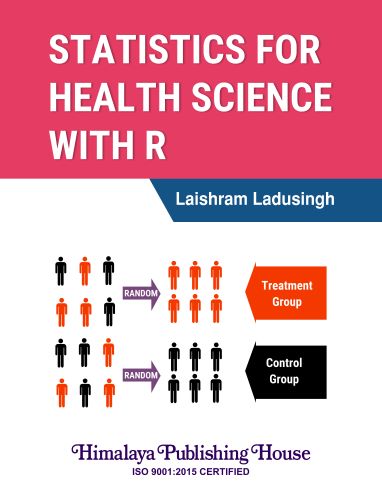The book provides a foundation of statistical methods and analysis for health science from the basics of measurements of variable to assessment of cause-and-effect relationships. The blend of theory and practical illustrations is at equal length and mathematical content is minimal. Use of open-source computing software R makes statistical presentation and analysis easy and more comprehensible.
The book is divided into thirteen chapters spanning from data representation and summarisation to testing of hypothesis, analysis of variance and covariance, categorical data analysis and linear regression analysis. Limited dependent analysis the epitome of health statistics is treated exclusively and covered in logistic, probit and multinomial regression. Entangling of hierarchical structure of biomedical data is emphasised and dealt in depth in the section on multilevel regression. Research designs for epidemiological studies, which is an integral part of postgraduate courses in public health and biostatistics is one of focus contents of the book with ample orientation and illustrations. Graphical and visual representation of statistical analysis makes it easier and convenient to interpret the results. Machine learning with illustrations of algorithms used in supervised and unsupervised learnings included in the book connects the readers with recent advancement in health statistics. The book shall meet the long-standing need for a user manual on statistics for health science.
The book is designed as a semester course for postgraduate students of public health, biostatistics and MBBS (Social and Preventive Medicine). Besides, it will be very useful for undergraduate and postgraduate project and internship works.
KEY FEATURES
- Extensive coverage of health indicators and assessment methods are included.
- Minimal theory and more illustrative examples make the book a practical guide.
- Exercises included in each chapter motivate students to practice and learn.
Contents –
Chapter 1 Measurement and Presentation of Data
1.0 Introduction
1.1 Data and Sources
1.2 Scales of Measurement
1.3 Discrete and Continuous Variables
1.4 Accuracy and Precision of Data
1.5 Diagrammatic Representation of Data
1.6 Descriptive and Analytical Statistics
1.7 Chapter Summary
Chapter 2 Measures of Location and Dispersion
2.0 Introduction
2.1 Measures of Central Tendency
2.1.1 The Arithmetic Mean
2.1.2 The Median
2.1.3 The Quartile, Deciles and Percentiles
2.1.4 The Mode
2.1.5 The Geometric Mean
2.1.6 The Harmonic Mean
2.1.7 The Weighted Mean
2.1.8 Appropriate Measures of Central Tendency
2.2 Measures of Dispersion
2.2.1 The Mean Deviation
2.2.2 The Variance and Standard Deviation
2.2.3 The Coefficient of Variation
2.2.4 The Range and Interquartile Range
2.2.5 The Skewness and Kurtosis
2.3 Chapter Summary
Chapter 3 Elements of Probability
3.0 Introduction
3.1 Terminologies of Probability
3.2 Classical Definition of Probability
3.2.1 Interpretation of Classical Definition of Probability
3.2.2 Sample Space and Probability
3.2.3 Permutations and Combinations
3.3 Axioms of Probability
3.3.1 Elementary Properties of Probability
3.4 Conditional Probability
3.5 Partition of Sample Space
3.6 Bayes’ Rule
3.7 Chapter Summary
Chapter 4 Probability Distribution
4.0 Introduction
4.1 Random Variable
4.2 Probability Distribution
4.2.1 Discrete Probability Distribution
4.2.2 Expectation and Variance of Discrete Random Variable
4.2.3 Continuous Probability Distribution
4.2.4 Expectation and Variance of Continuous Random Variable
4.3 Bernoulli Trial and Distribution
4.4 Binomial Distribution
4.4.1 Mean and Variance of Binomial Distribution
4.5 Geometric Distribution
4.5.1 Mean and Variance of Geometric Distribution
4.6 Negative Binomial Distribution
4.6.1 Mean and Variance of Negative Binomial Distribution
4.7 Hypergeometric Distribution
4.7.1 Mean and Variance of Hypergeometric Distribution
4.8 Poisson Distribution
4.8.1 Mean and Variance of Poisson Distribution
4.9 Normal Distribution
4.9.1 Mean and Variance of Normal Distribution
4.9.2 Properties of Normal Distribution
4.9.3 R Codes for Normal Distribution
4.10 Chapter Summary
Chapter 5 Joint and Sampling Distribution
5.0 Introduction
5.1 Joint and Marginal Probability Distribution
5.1.1 Joint Probability Distribution
5.1.2 Marginal Probability Distribution
5.2 Sampling Distribution of Sample Mean
5.3 Central Limit Theorem
5.4 Convolutions
5.5 Special Distributions
5.5.1 Gamma Distribution
5.5.2 Chi-Square Distribution
5.5.3 F-Distribution
5.5.4 Students’ t-Distribution
5.6 Chapter Summary
Chapter 6 Testing of Hypothesis
6.0 Introduction
6.1 Parameter and Statistic
6.2 Statistical Hypothesis
6.3 Types of Error and Test Statistics
6.3.1 Types of Error
6.3.2 Test Statistic
6.4 Critical Region and Power of Test
6.4.1 Critical Region
6.4.2 Power of Test
6.5 Test of Statistical Hypothesis
6.5.1 Most Powerful Test
6.5.2 Neyman-Pearson Lemma
6.5.3 Uniformly Most Powerful Test
6.5.4 Generalised Likelihood Ratio Test
6.5.5 P-Value
6.5.6 Measuring Effect Size
6.5.7 Steps for Hypothesis Testing
6.6 Test for Means
6.6.1 One Sample Test for Mean
6.6.2 Two Sample Test of Mean
6.7 Test for Proportion
6.7.1 One Sample Test for Proportion
6.7.2 Two Sample Test for Proportions
6.8 Power of Test
6.8.1 Power for Normal Test
6.8.2 Power for t-Test
6.8.3 Power for Test for Proportion
6.9 Sample Size Determination
6.10 Test for Variance
6.10.1 Variance Ratio Test
6.11 Chapter Summary
Chapter 7 Analysis of Categorical Data
7.0 Introduction
7.1 Outcome Indicators for Health and Demography
7.2 Odds and Odds Ratios
7.3 Relative Risk
7.4 Chi-Square Test of Independence
7.5 Marginal and Conditional Odds Ratio
7.6 Cochran-Mantel-Haenszel Test
7.7 Loglinear Models
7.8 Chapter Summary
Chapter 8 Analysis of Variance and Covariance
8.0 Introduction
8.1 One-way Analysis of Variance
8.2 Priori and Post-hoc Comparisons
8.3 Two-way Analysis of Variance
8.4 Interaction of Factors
8.5 Random Effects Model
8.6 Analysis of Covariance
8.7 Chapter Summary
Chapter 9 Linear Regression Analysis
9.0 Introduction
9.1 Simple Linear Regression
9.1.1 Estimation of β0 and β1
9.1.2 Significance of Regression and Coefficient of Determination
9.1.3 Assumptions of Simple Regression
9.2 Multiple Linear Regression
9.2.1 Assumptions of Multiple Linear Regression
9.2.2 Estimation and Testing of Hypothesis of Regression Coefficients
9.2.3 Analysis of Variance and Coefficient of Determination
9.3 Regression Diagnostics
9.3.1 Dependent Variable and Linearity Assumptions
9.3.2 No Autocorrelation of Errors
9.3.3 No Multicollinearity
9.3.4 Homoscedasticity and Normality of Residuals
9.3.5 Detection of Outliers
9.3.6 Test for Model Comparison
9.4 Number of Predictors
9.4.1 Backward Selection
9.4.2 Forward Selection
9.4.3 Stepwise Selection
9.5 Confounding and Interaction Effects
9.5.1 Confounding Effect
9.5.2 Interaction Effect
9.6 Standardised Regression Coefficients
9.7 Additional Features of R
9.8 Chapter Summary
Chapter 10 Logistic, Probit and Multinomial Regressions
10.0 Introduction
10.1 Basics of Logistic Regression
10.2 Estimation and Hypothesis
10.2.1 Estimation of Coefficients
10.2.2 Testing of Hypothesis
10.3 Goodness of Fit
10.3.1 Psuedo R2
10.3.2 Deviance Statistic
10.3.3 Akaike Information Criterion (AIC)
10.3.4 Hosmer-Lemeshow Test
10.4 Introduction to Probit Regression
10.5 Multinomial Logitic Regression
10.5.1 Estimation of Parameters
10.6 Ordered Logit Regression
10.6.1 Order Logistic and Probit Regression Models
10.7 Chapter Summary
Chapter 11 Multilevel Regression Analysis
11.0 Introduction
11.1 Basics of Multilevel Regression
11.2 Diagnostics Test for Multilevel Regression
11.3 Three-level Regression Models
11.4 Multilevel Logistic Regression
11.5 Multilevel Panel Regression
11.6 Chapter Summary
Chapter 12 Research Designs
12.0 Introduction
12.1 Types of Research Design
12.2 Descriptive Research Design
12.3 Cross Sectional Research Design
12.3.1 Sample Size Determination
12.3.2 Sampling Weight
12.3.3 Weighting of Survey Data
12.3.4 Recalibration of Sampling Weight
12.4 Case-Control Design
12.4.1 Criteria for Selection of Case and Control
12.4.2 Analysis of Case-control Study
12.4.3 Matching Analysis of Case-control Study
12.5 Cohort Study
12.5.1 Analysis of Retrospective Cohort Study
12.6 Pre-post Design
12.7 Randomised Control Trial
12.7.1 Types of Error and Power
12.7.2 Sample Size for Randomised Control Trial
12.8 Cross-over Design
12.8.1 Analysis of Cross-over Design
12.9 Factorial Design
12.10 Design Estimates
12.11 Chapter Summary
13 Artificial Intelligence and Machine Learning for Health Science
13.0 Introduction
13.1 Machine Learning
13.1.1 Supervised Learning
13.1.2 Unsupervised Learning
13.1.3 Reinforcement Learning
13.2 Regression
13.2.1 LASSO Regression
13.2.2 Ridge Regression
13.3 Classification
13.3.1 Logistic Regression
13.3.2 K-Nearest Neighbour
13.3.3 Support Vector Machine
13.3.4 Decision Trees
13.3.5 Random Forests
13.3.6 Naïve Bayes
13.3.7 Merits and Demerits of Classification Algorithms
13.4 Evaluation Metrics of ML Classification Algorithms
13.5 Clustering: Unsupervised Machine Learning
13.5.1 K-Means Clustering
13.5.2 Hierarchical Clustering
13.6 Dimensionality Reduction: Unsupervised Machine Learning
13.6.1 Principal Component Analysis
13.6.2 Factor Analysis
13.7 Reinforcement Learning in Healthcare
13.8 Chapter Summary






